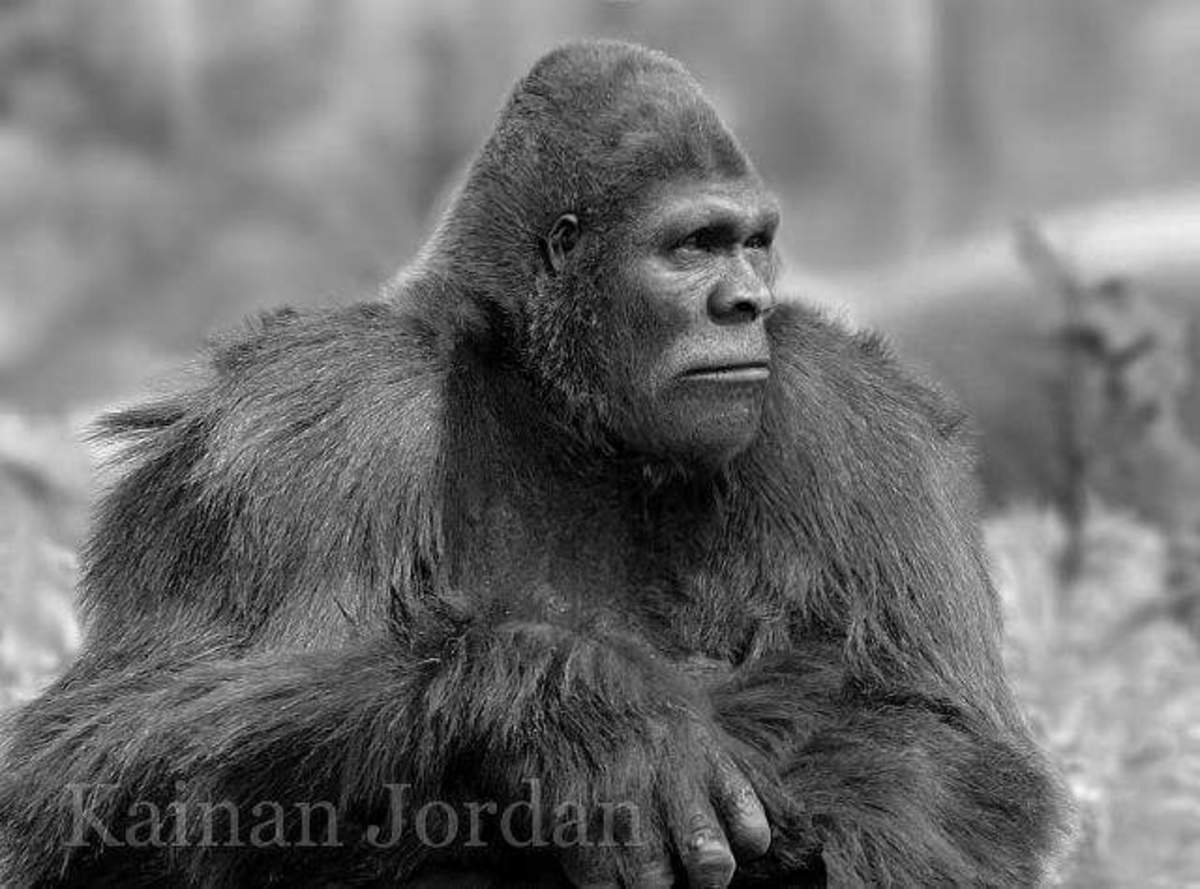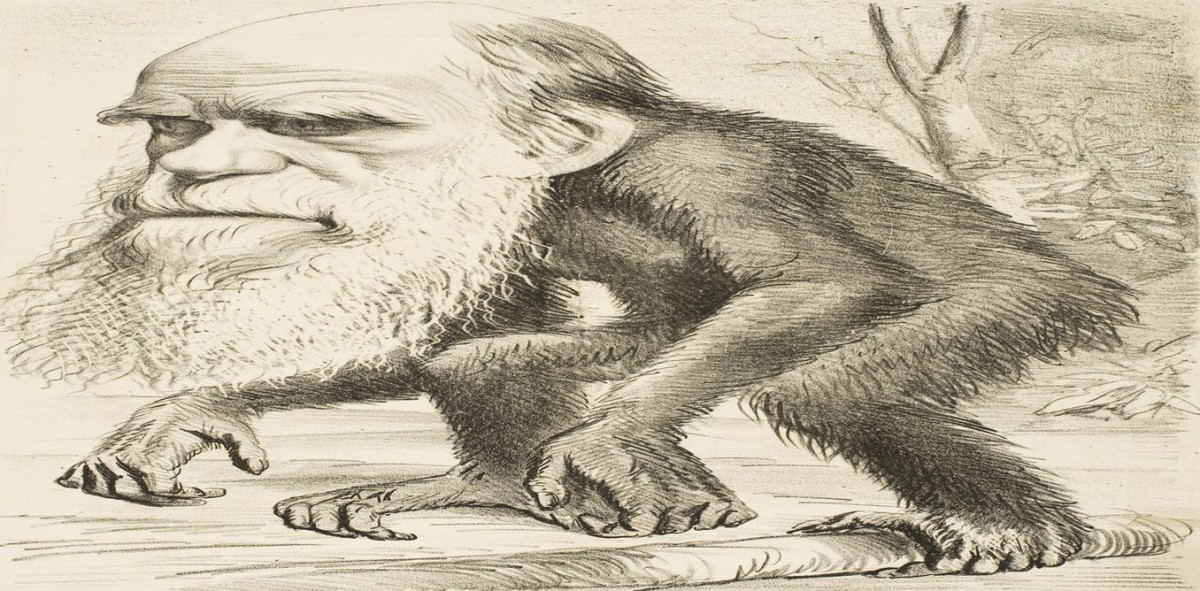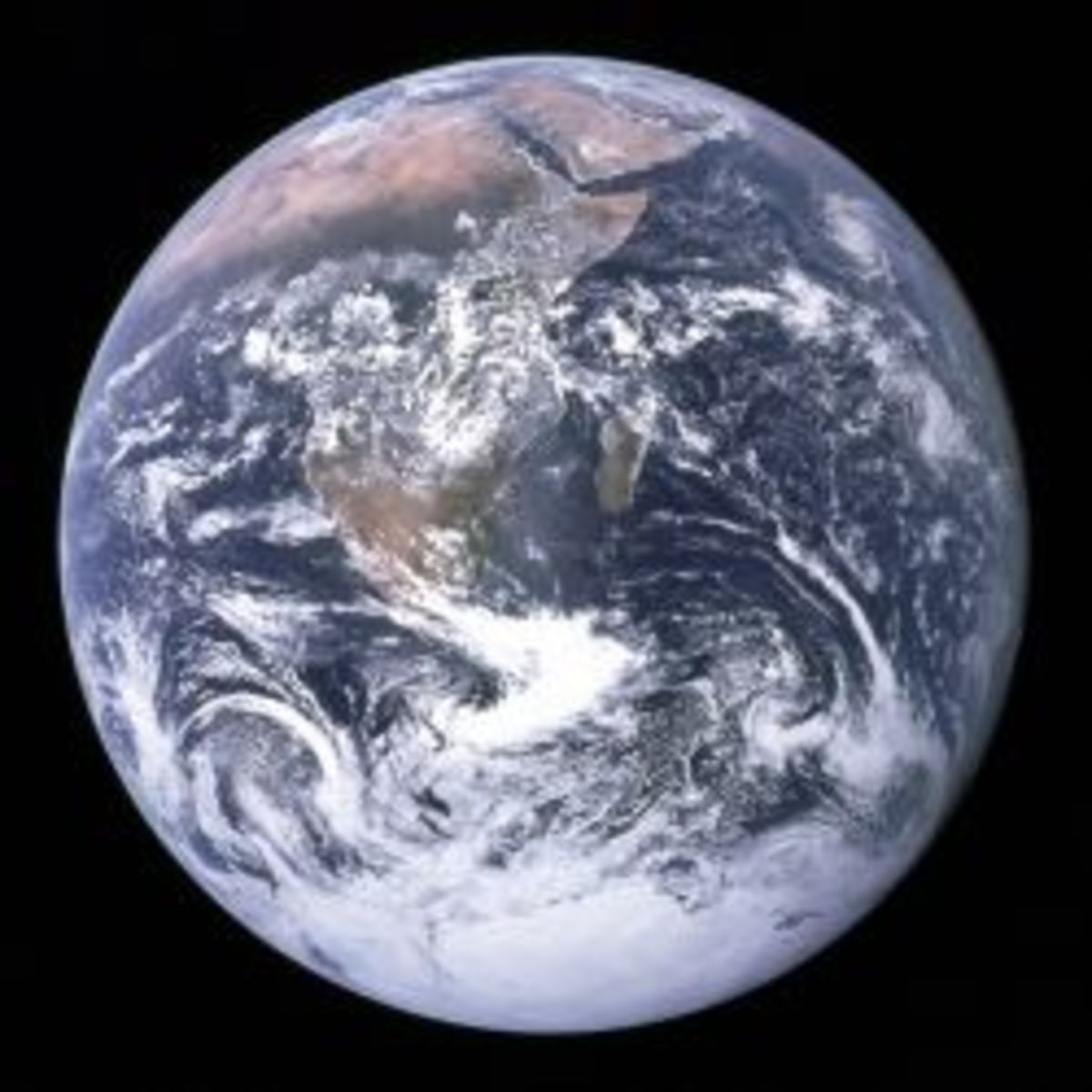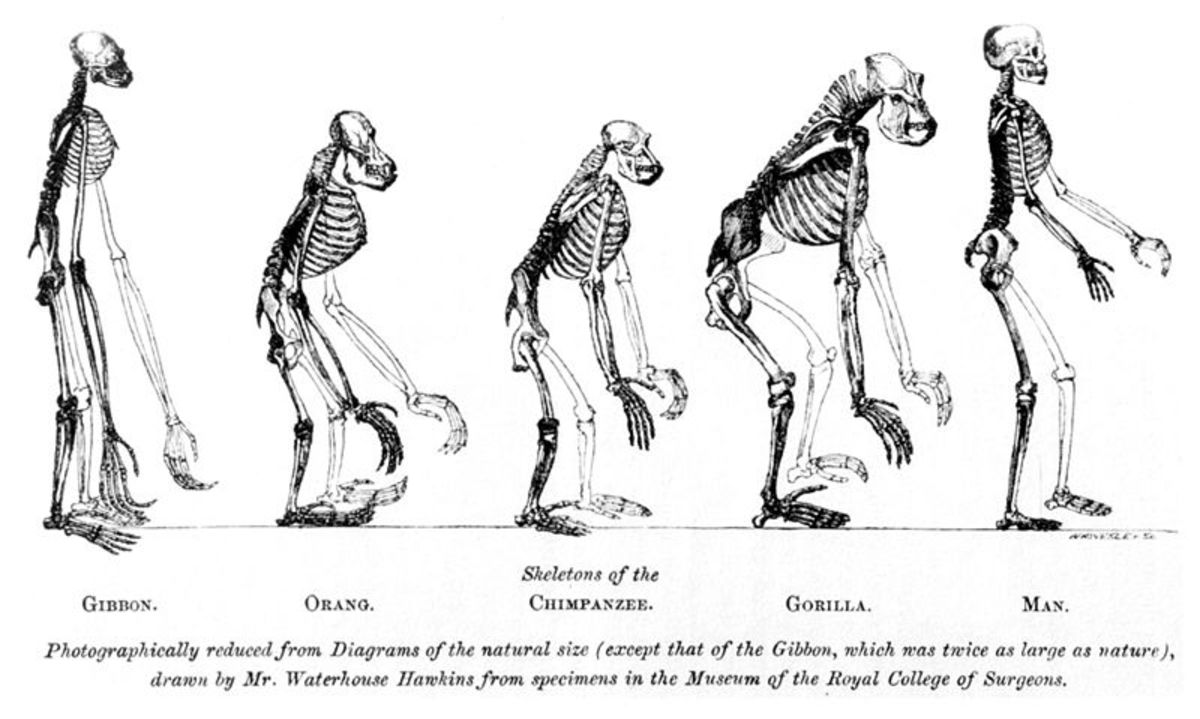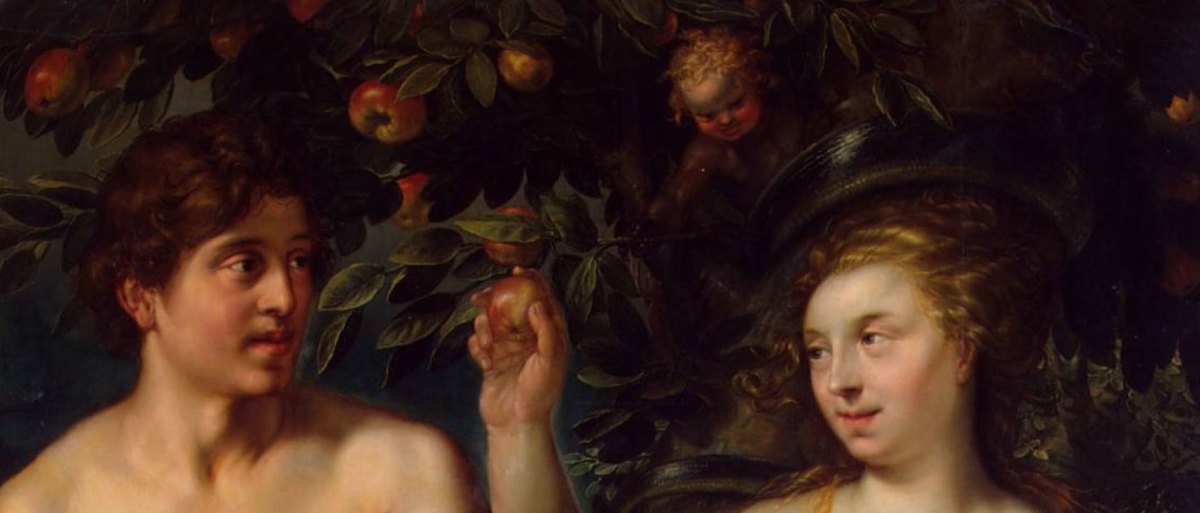Biology Basics: Theory of Evolution
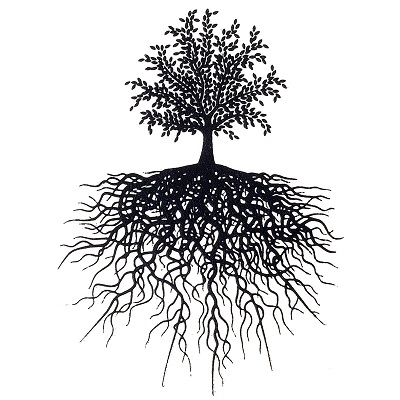
Genesis
The story of life must begin from the earliest conception of creation including the birth of chemistry, physics and formation of the cosmos. While most events that took place before the emergence of organic life are theoretical, it helps us better understand the substrate from which life could take root and flourish into what we see today...
To summarize, basic evolutionary theory incorporates 7 interrelated stages according to our most current scientific theories:
- Cosmic Evolution - Development of matter, energy, and time out of nothing
- Stellar Evolution - Growth of stars and gas giants from elementary particles
- Chemical Evolution - Synthesis of 88 natural elements from hydrogen and helium
- Planetary Evolution - Development of planetary systems and objects
- Organic Evolution - Birth of organic life from inorganic matter
- Macro-Evolution - Transition from one form of life to another
- Micro-Evolution - Multitudes and variations of similar life forms
Big Bang
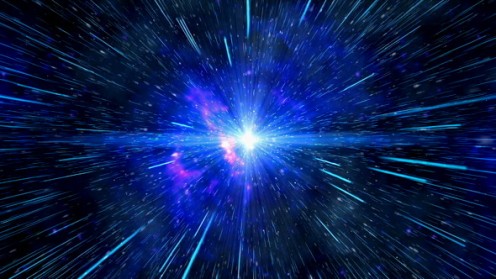
Let's reel the clock back 13.7 billion years when globs of hydrogen and helium were blown outward from a single point in a vacuum of nothing. This cascade of debris spiraled violently into the farthest reaches of the universe. Through gravity, immense heat and pressure, particles began to form various molecular bonds which would congeal into larger forms of mass including stars, planets and moons. Vast clusters of stars and planets continued to take shape into spiraling galaxies.
Hubble Photograph of Nearby Galaxies
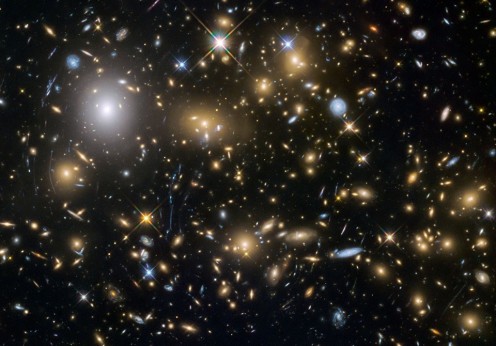
Within each galaxy exist systems of orbiting planets around stars. The composition of stars and their neighboring planets are unique to their position in relationship to available elements and cosmic climates. A planets size, composition, and distance from stars would determine the conditions of their surface. Through a combination of miraculous conditions, life was made possible on planets like our own while others became too violent and uninhabitable.
Goldilocks Planet
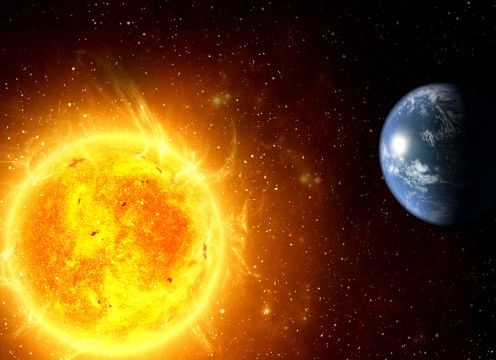
Roughly 4.5 billions years ago, Earth formed after long periods of rapid heating and cooling. The expulsion of gases from the surface generated a crude atmosphere although quite different than what we have today. If we move ahead another billion years from that point, we begin to see initial evidence of the first single celled organisms including bacteria. The nature of their surrounding elements and conditions illustrates an extreme yet fertile soup from which all life sprouted on earth.
Fossilized Cyanobacteria - Approximately 3.5 Billion Years Old
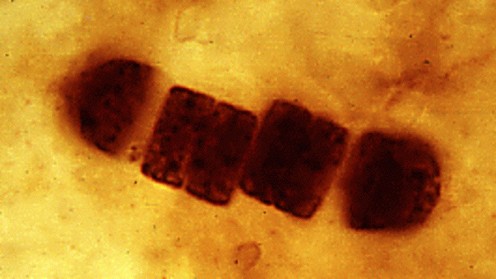
As discussed in an earlier featured article, the most common living cells found are not much different than the very first sprawling microscopic life. What's more, prokaryotic bacteria and other microorganisms are so good at surviving extreme conditions that they remained over 3 billion years through every major cataclysm and mass extinction. Suffice it to say, they are likely to outlive every known creature on Earth from here forward.
We also have these ancestral organisms to thank for the livable conditions that we inhabit today. Through a process commonly attributed to plant life called "photosynthesis", organisms such as cyanobacteria (above) could metabolize toxic elements and breathe oxygen back out into the atmosphere. As noted by Andrew Knoll, Professor of Natural History at Harvard University, these organisms were "the working-class heroes of the Precambrian Earth".
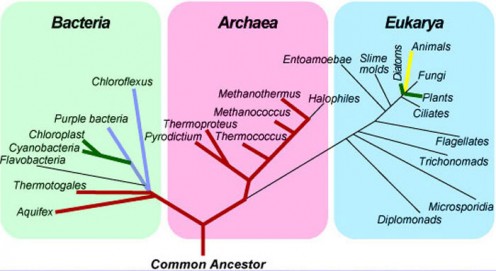
Out of a small variety of microorganisms grew multiple variations of different life forms across time; all with a single common ancestor. But none of this happened over-night precisely. So what happened?
Aristotle (384 BC - 322 BC)

Classic Element Model

Abiogenesis - Spontaneous Generation
Before humans could even conceive of organisms as small as bacteria, some still attempted to account for the origins of life. According to Greek proto-scientists like Aristotle, it was believed that all matter could be broken down into 4 constituent elements: earth (rock), air, fire and water. Of these elements contained basic characteristics of hot, cold, dry and wet.
Aristotle posited that even living organisms were structured by various mixtures of these elements in addition to an intrinsic "life force" in which he described as the "pneuma" which later translated into "anima" meaning "soul".
The obvious phenomena of sex and procreation was not lost on him but other evidence lead him to believe that life could be inexplicably produced at random from inert compounds.
"All those which do not bud off or 'spawn' are spontaneously generated. Now all things formed in this way, whether in earth or water, manifestly come into being in connexion with putrefaction and an admixture of rain-water. For as the sweet is separated off into the matter which is forming, the residue of the mixture takes such a form. Nothing comes into being by putrefying, but by concocting; putrefaction and the thing putrefied is only a residue of that which is concocted. For nothing comes into being out of the whole of anything, any more than in the products of art; if it did art would have nothing to do, but as it is in the one case art removes the useless material, in the other Nature does so. Animals and plants come into being in earth and in liquid because there is water in earth, and air in water, and in all air is vital heat so that in a sense all things are full of soul. Therefore living things form quickly whenever this air and vital heat are enclosed in anything. When they are so enclosed, the corporeal liquids being heated, there arises as it were a frothy bubble. Whether what is forming is to be more or less honourable in kind depends on the embracing of the psychical principle; this again depends on the medium in which the generation takes place and the material which is included."
- Aristotle History of Animals
Jean-Baptiste Lamarck (1744-1829)
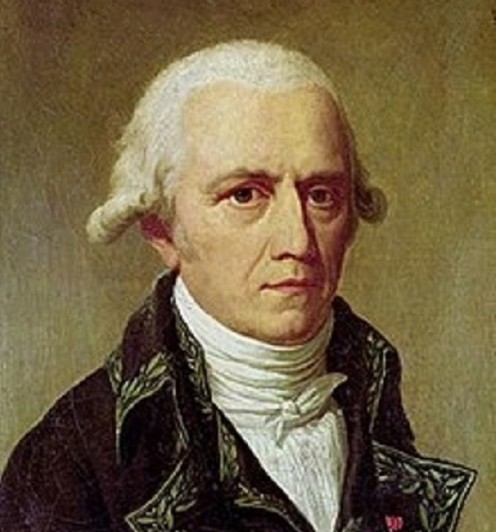
Classic Giraffe Example
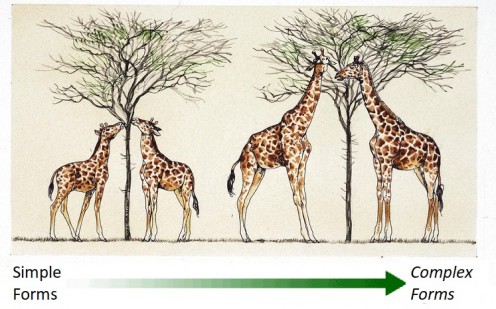
Driven to Complexity
Jean-Baptiste Lamarck was a soldier of the Seven Years' War in France until peace was declared in 1763. He would go on to become appointed the professor of natural history of insects and worms; a field in which he knew very little about. It was Lamarck who eventually coined the term "invertebrates" (without backbones) and his studies would reveal a vast diversity of organisms.
". . . we perceive that, relative to the animal kingdom, we should chiefly devote our attention to the invertebrate animals, because their enormous multiplicity in nature, the singular diversity of their systems of organization, and of their means of multiplication, . . . , show us, much better than the higher animals, the true course of nature, and the means which she has used and which she still unceasingly employs to give existence to all the living bodies of which we have knowledge."
Through his observations of the natural world, Lamarck began to notice interesting trends in physical characteristics as they related to the environment...
Changes in the environment lead to changes in the needs of organisms which in turn caused changes in their behavior. Such behavior lead to greater or lesser use of a given organ or structure. Prolonged use would cause the structure to increase in size over multiple generations, whereas disuse would cause it to shrink or even disappear...
(Consider the image above. As the available vegetation grew out of reach, the average length of the Giraffe's legs and neck grew longer with each passing generation)
In summary, all changes that occurred during adaptive processes were heritable and accounted for the continuous and gradual change in organisms across time. Lamarck argued that all organisms are driven upward inexorably by nature from simple forms to more complex or "perfect" forms.
"Nature, in producing in succession every species of animal, and beginning with the least perfect or simplest to end her work with the most perfect, has gradually complicated their structure."
- JP Lamarck Philosophie zoologique
Charles Darwin (1809 - 1882)
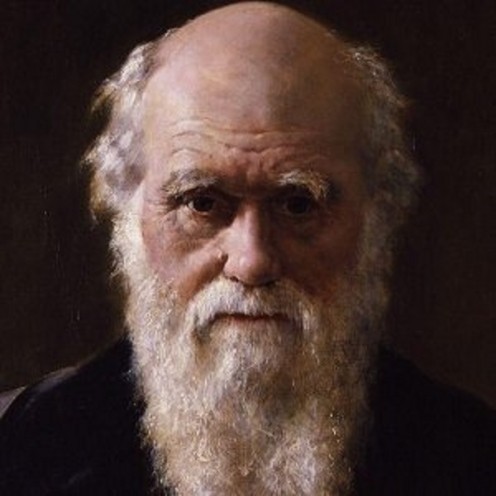
Galapagos Finches
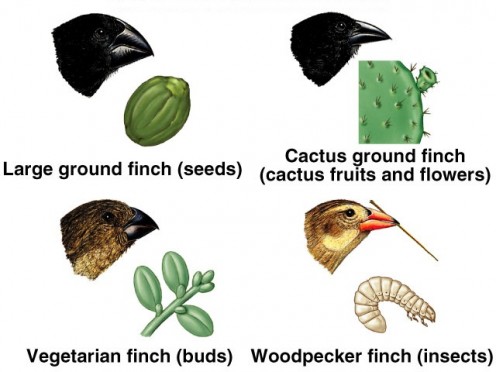
Natural Selection
Spending most of his adult life and some of his childhood compelled by the curiosities of nature, Charles Darwin studied everything he could get his hands on: barnacles, earthworms, rocks, birds, tortoises, fish, insects and, on occasion, members of his own family.
It wasn't until a surveying expedition on the HMS Beagle in 1831 that he began to take a closer look at certain contributors of species survival. Throughout his voyage, the most notable records were gathered through his observation of finches on the Galapagos islands off the coast of South America. Many of them appeared quite similar to the mainland finches but Darwin recorded over a dozen different varieties of beak shapes and sizes which seemed to be well-suited to the available food on each island. For example, if an island produced more hard seeds the beaks of local finches were thicker whereas other beaks were long and pointed to penetrate fruit and cacti on other islands (see image above). Similar to Lamarck's observations, Darwin concluded that the finches increased their fitness in relationship to their environment which increased their relative ability to survive and produce offspring.
From there, Darwin would go on to publish his famous Origin of Species by Means of Natural Selection in 1859. In his writing he highlights the four major principles of natural selection:
- Variation - Members within a population of species exhibit variations of appearance and behavior such as size, shape, color, sounds and reflexes. These traits are what we would consider today as "phenotypes". Conversely, there are some traits shared by all members of a species such as number of eyes and limbs.
- Inheritance - Many of these variations are heritable and can be passed on to offspring while some traits are only favorable if influenced by specific conditions within the environment.
- Rate of Population Growth - Species will occasionally produce more offspring than what the environment can sustain which leads to a struggle for resources therefore increasing the rate of mortality. Darwin regarded this phenomena as the "struggle for existence".
- Differential Survival and Reproduction - Members of a species that possess traits well suited for the aforementioned battle for resources are more likely to leave offspring. A process familiar to most as the "survival of the fittest".
“…as natural selection acts by competition for resources, it adapts the inhabitants of each country only in relation to the degree of perfection of their associates”
In short, the only way for natural selection to operate on specific traits is the trait must possess heritable variation and grant some form of advantage in the competition for resources. (We have discovered other means by which traits can change since Darwin's time but this theory was nonetheless revolutionary). Comparative advantage is the method by which natural selection is carried out in contrast to earlier theories of a standard "design".
In the video below is one of the most famous examples of natural selection...
Peppered Moth
Darwinian Theory Cont.
In addition to Darwin's contributions of natural selection, he formulated broader theories about the consequences of evolution over the course of Earth's history. Some of his major points include:
- The description of species as populations of interbreeding organisms change across time and space. Fossil records served as evidence that species that we see today differ from those of the past.
- All organisms share a common ancestor. Populations may break off and divide into other variations of species but have traceable origins to a common ancestor. For example, humans share a common ancestor with chimpanzees dating back around 8 million years ago.
- Major evolutionary change is an agonizingly gradual process that takes millions of years, again, as evidenced by fossil remains.
"I have attempted to show that the geological record is extremely imperfect; that only a small portion of the globe has been geologically explored with care; that only certain classes of organic beings have been largely preserved in a fossil state; that the number both of specimens and of species, preserved in our museums, is absolutely as nothing compared with the incalculable number of generations which must have passed away even during a single formation; that, owing to subsidence being necessary for the accumulation of fossiliferous deposits thick enough to resist future degradation, enormous intervals of time have elapsed between the successive formations; that there has probably been more extinction during the periods of subsidence, and more variation during the periods of elevation, and during the latter the record will have been least perfectly kept; that each single formation has not been continuously deposited; that the duration of each formation is, perhaps, short compared with the average duration of specific forms; that migration has played an important part in the first appearance of new forms in any one area and formation; that widely ranging species are those which have varied most, and have oftenest given rise to new species; and that varieties have at first often been local. All these causes taken conjointly, must have tended to make the geological record extremely imperfect, and will to a large extent explain why we do not find interminable varieties, connecting together all the extinct and existing forms of life by the finest graduated steps"
-Charles Darwin Origin of Species
DNA
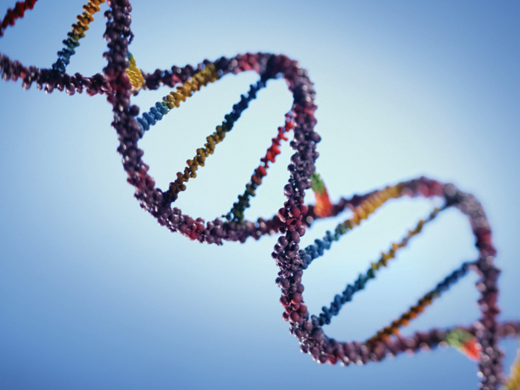
Genetic Theory
It wasn't until the mid-twentieth century that science could point to a molecular basis for evolution. The famous discovery of the double-helix by James Watson and Francis Crick in 1953 revolutionized how we viewed components of trait inheritance.
By that time, we understood that complex organisms are in fact larger amalgams of multi-cellular structures. Within each cell contains a nucleus, with the exception of bacteria, and in each nucleus rest tightly packed strands of genetic information that determine the size, structure and function of each cell. A specific percentage of traits are passed on by each parent and combined to produce a unique variation in their offspring. After so many generations of offspring, you might begin to notice certain traits that have been conserved and selected for which become visible from observations of natural selection. The introduction of DNA may appear relatively immaterial to previous notions about trait inheritance but we could finally identify the blueprint for what all life shares in common.
For more basic information about the structure of cells and DNA click here
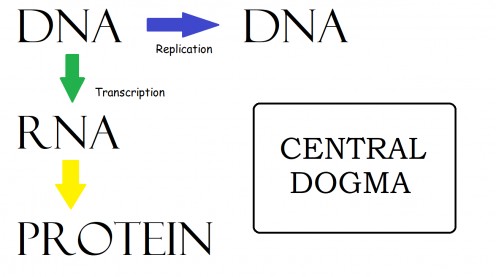
Central Dogma
The original assumption about the function of DNA was that DNA sequences accounted for specific genes which would then either be used to replicate identical cells or be transcribed by a cell using RNA to manufacture proteins that make up tissue, enzymes, neurotransmitters and antibodies.
Exons & Introns
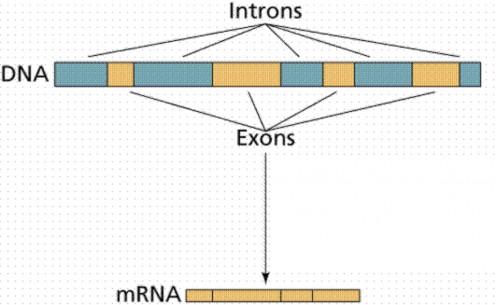
Epigenetics
It was later discovered that gene sequences were somewhat incomplete and between these sequences existed relatively useless units of information. The relevant units within a gene sequence are called "exons" while the units in between are called "introns" (above).
To make sense of this jumbled string of information, "splicing enzymes" must go in and snip out the exons and sew them back together to be able to manufacture a protein. What's more, we discovered through this process that different proteins can be assembled using the same gene sequence.
Example 1:
Imagine a gene sequence that codes for a protein called ABC. Splicing enzymes can go in and reassemble this sequence in a multitude of combinations therefore producing different proteins. You might end up with something like...
AB, AC, BA, BC, A, B, C,
From here we discard the idea that one gene only accounts for one type of protein. But wait, it gets more complicated...
There seem to be very long stretches of DNA that are non-functional in that they do not code for proteins whatsoever. Instead, whatever is upstream of a protein activating gene is actually information about whether or not genes are turned "on" or "off". A staggering 95% of our DNA is actually devoted to DNA regulation of the remaining 5%. It does so by modulating what can come into contact with protein activating genes.
What comes into contact with genes? Transcription factors (TF). These are essentially promoters originating from outside the nucleus that initiate a cascade of chemical messengers across the DNA sequence so transcription can occur. From here we delve into an entire world of influences beginning from within the cell, to the rest of the body, and to the rest of the outside world.
Example 2: Testosterone (TF) is secreted from male testes which then travel through the blood making contact with an androgen receptor on a muscle cell activating genes within the cell to manufacture structural proteins for overall muscle growth.
Example 3: A mother smells pheromones (TF) from her newborn baby which make contact with the olfactory bulbs deep within her nose thereby activating a chain of events causing secretion of milk.
Mutation
If we apply the basic principles of gene sequences we begin to see how many things can influence the expression of DNA. It would be romantic to think that genes passed on from organism to organism are perfectly arranged, however, some of the coding within any given genome can be miscopied producing what we call "mutations". Specific points along a gene sequence may contain an error. Such errors might be inconsequential while others can be catastrophic (cancer, deformities). If 1% of a genome is composed of mutated sequences, you might only see physical manifestations of this after a hundred generations or so have passed.
Example: Minute alterations in DNA sequences can be seen in selective breeding of canines for particular desirable traits. Long hair, short hair, black, white, spotted, etc. Every so often we encounter unpredictable health problems in canines as a result of selective breeding.
On a more positive note, research has provided invaluable insight on the genetic influences on behavior by studying rats who possess genes which make them predisposed to alcoholism and anxiety. By examining the context surrounding micro-mutations, we have a much better idea about how to identify genetic contributors of disease and mental illness.
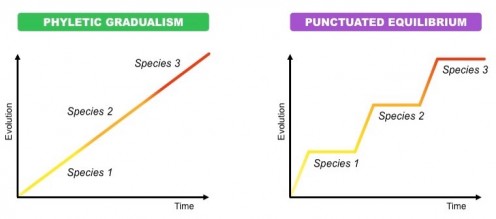
Gradualism VS Punctuated Equilibrium
Over the course of hundreds, thousands, and millions of years we find that small point mutations in genes produce gradual albeit significant changes in species development. While many animal species share common genes, selection and mutation of genes over long periods produce more complex effects in organisms.
Example: Consider the FOXP2 gene which has been identified as playing a primary role in the development of speech and language across many different species, i.e. bird song, dog barking, ultrasonic chatter in mice and rats. In humans, this gene is expressed much more dynamically through the use of vocalized symbols and language. From this we see that a single common gene among the animal kingdom can be developed much more extensively apart from other organisms but requires continual selection over thousands of years to become what it is today.
In keeping with Darwinian theories of gradual evolution, this demonstrates the slow, creeping process illustrated on the figure above (top left). That is, until a paleontologist by the name of Steven Jay Gould brought this gradualistic theory into question by presenting fossil evidence of rapid changes in the morphology of species. He argued that there were long periods of stasis punctuated by radical spurts in evolution called "punctuated equilibrium" (top right). This is thought to have occurred through sudden demands brought about by a changing landscape whether it be from extreme alterations in climate, famine, or other major cataclysms.
One of the prevailing critiques of this theory is that fossil evidence could only exhibit morphological changes in species but could not reveal anything about the organs and tissues that were subject to decomposition. Furthermore, there are large gaps in the timeline between physical remains which might be the only explanation for these spontaneous leaps. Lastly, what Gould considered rapid changes in species development actually occurred upwards of 100,000 years at a time. This might seem rapid in contrast to the cosmic antiquity of the planet but it's not exactly antithetical to the gradualist perspective.
Survey
Was this article useful or informative?
Resources
Darwin, C. 1959. On the Origin of Species by Means of Natural Selection, or, the Preservation of Favoured Races in the Struggle for Life. London: J. Murray.
Evolution.berkeley.edu. (2017). Early Concepts of Evolution: Jean Baptiste Lamarck. [online] Available at: https://evolution.berkeley.edu/evolibrary/article/history_09 [Accessed 30 Nov. 2017].
Globalchange.umich.edu. (2017). Evolution and Natural Selection. [online] Available at:https://globalchange.umich.edu/globalchange1/current/lectures/selection/selection.html [Accessed 30 Nov. 2017].
Knoll, A. (2003) Life on a Young Planet: The First Three Billion Years of Evolution on Earth. Princeton University Press. Princeton, NJ
Learner.org. (2017). The Habitable Planet Unit 1 - Many Planets, One Earth // Online Textbook. [online] Available at: http://www.learner.org/courses/envsci/unit/text.php?secNum=7&unit=1 [Accessed 30 Nov. 2017].
New Scientist. (2017). Timeline: The evolution of life. [online] Available at: https://www.newscientist.com/article/dn17453-timeline-the-evolution-of-life/ [Accessed 30 Nov. 2017].
Physicsoftheuniverse.com. (2017). The Beginnings of Life - The Physics of the Universe. [online] Available at: http://www.physicsoftheuniverse.com/topics_life.html [Accessed 30 Nov. 2017].
Sapolsky, R.. (2017). 4. Molecular Genetics I. [online] Available at: https://www.youtube.com/watch?v=_dRXA1_e30o&index=4&t=6s&list=PL150326949691B199 [Accessed 30 Nov. 2017].
Talkorigins.org. (2017). Pasteur, fermentation, contagion, and proving anegative. [online] Available at: http://www.talkorigins.org/faqs/abioprob/spontaneous-generation.html [Accessed 30 Nov. 2017].
Ucmp.berkeley.edu. (2017). Fossil Record of the Bacteria. [online] Available at: http://www.ucmp.berkeley.edu/bacteria/bacteriafr.html [Accessed 30 Nov. 2017].
Ucmp.berkeley.edu. (2017). Jean-Baptiste Lamarck (1744-1829). [online] Available at: http://www.ucmp.berkeley.edu/history/lamarck.html [Accessed 30 Nov. 2017].
© 2017 Jessie Watson

